YOKOHAMA VINTAGE HELIOX – HELIUM DIVING HELMET
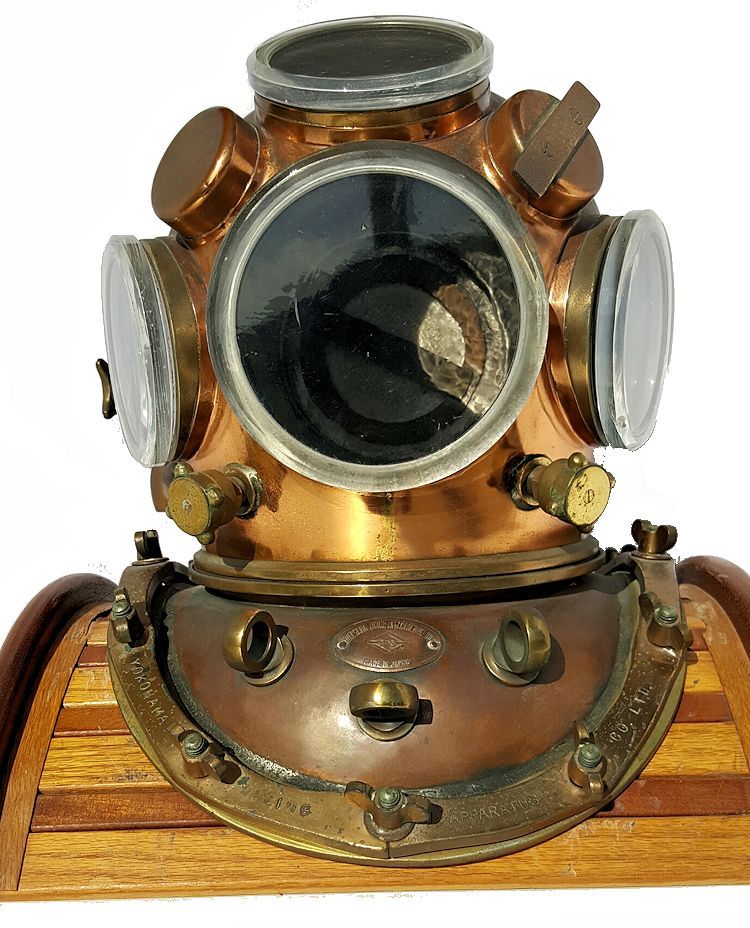 TOTAL WEIGHT: 65 lbs.
TOTAL WEIGHT: 65 lbs.
SERIAL NUMBER: None DATE: 1970 ESTM
STAND INCLUDED
Presentedis a Yokohama Diving Company 12 bolt mixed
gas vintage dive helmet. It was the backup hat for a commercial diver which accounts for its light use and excellent condition
for a helmet that is at least 46 years old. Approximately, 30 years ago it was purchased by the diver’s neighbor
for display and is new to the market. It is reported that the release valve, the high pressure line,
check valve and spit valve are all in good shape. It has minor dents and scratches, but no pitting in the copper
and a fine patina overall. The lights have few if any scratches. The Yokohama name plate is sharply
struck and all part numbers match and are as detailed in the MARKINGS Section below. Each of it’s 4 straps
have the number 7 stamped in their bottoms. The bonnet and corselet are commercially fabricated and include a block
style intake hoke, 2 chest rings mounted to the straps to allow room for the 2 chest plate lugs. There is no communications
equipment, but it was the intention of the diver to fit some. Hence, the terminal lugs for the comm hookup are present. The
clear finished NATURAL WOOD STAND IS INCLUDED. This design was manufactured from 1966 – 1990. and few are remaining in use
or on the market. DESCO’s Bill, furnishes this bit of dive helmet background
history: “Back in the days when offshore oil diving was starting up in California, Bob Kirby came up with
this design as a alternative to the US Navy MK V Helium helmet. His first six helmets were built using DESCO Sponge Helmets.
He then switched to Yokohama helmets for his later production. When he quit making them himself, Yokohama took over and continued
their production until 1990. This great looking hat will make a perfect addition to a collection of fine vintage diving gear and
will appeal to the advance collector
HELMET
MARKINGS The brail tops are matching numbers 1 2 3 4 to line up when attaching to helmet. On the bottom of each brail is the
number 7. On the front two brails it has Yokohama diving on one and Apparatus Co Ltd. on the other. There is no serial number
which my good friend Leon Lyons tells me is correct. Leon says, helium helmets made in Japan do not have serial numbers. There
is a twin to this one on page 278 of his acclaimed book, “Helmets of the Deep”.
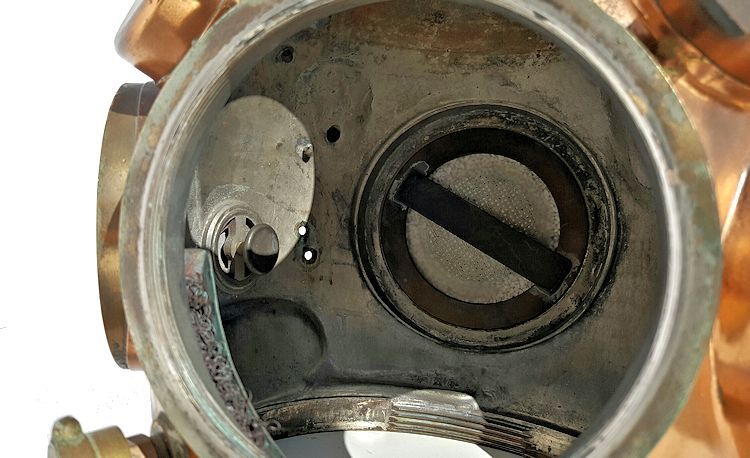 Inside the bonnet of the Yokohama Helium Hat
Inside the bonnet of the Yokohama Helium Hat
CONDITION:
Considering it’s approximate 46 year age and use, it is in very good condition overall. There are
only a few small dents and minor abrasions present showing its light use. All of the the original tinning has
been lost due to past polishing or is worn off. The air vents are all intact. The right side chin relief valve,
spit cock handle, front door wing nut, all turn easily. The speaker housing is empty. No check valve is
fitted, and no speaker is fitted. Two terminal plugs have been installed in anticipation of fitting a comm system.
Like all used diving gear, this is being sold for DISPLAY ONLY. It should
not be dived without having passed inspection by a certified dive shop
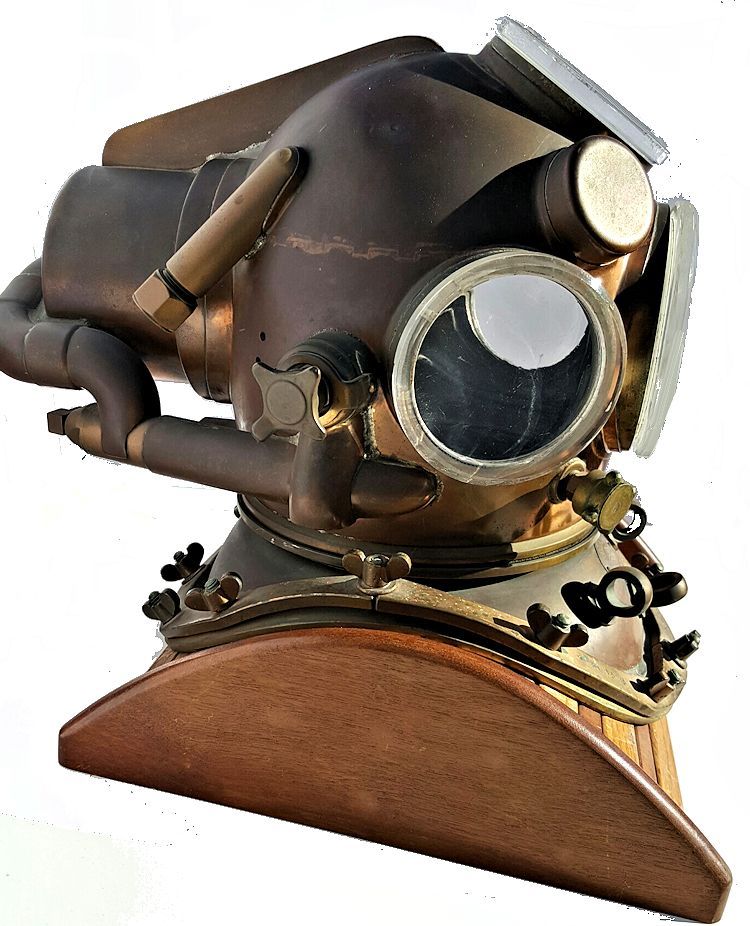
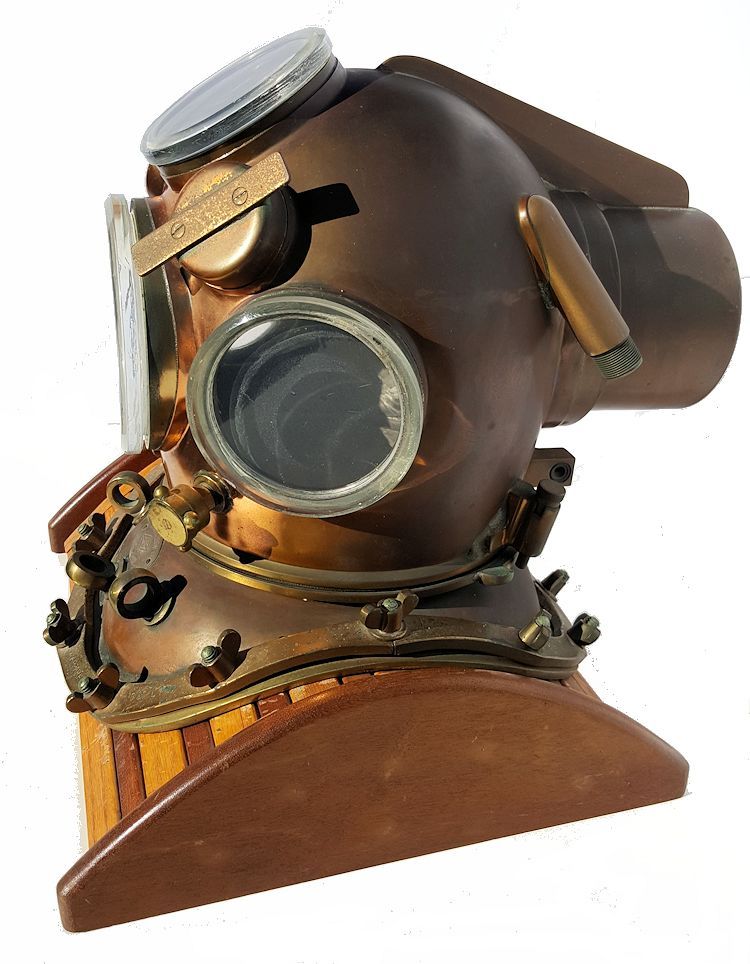 Left and Right side of the
Left and Right side of the
helmet. The stand is INCLUDED!
Famous Collector, Anthony Pardoe’s Description:
Pgs 214-215 , Vol 1 – Diving Helmets and Equipment Through the Ages “All
the extra fittings make this a very large heavy helmet. The badge is the same as on the 12 bolt Yokohama, with TS and the
motif stamped into the front brail. The front brails have extra large securing rings attached, originally used for the diver
to secure himself within the Bell when returning from his dive. All the windows screw out and are made of Plexiglass which
is almost as strong as steel, making window guards unnecessary. The numberM 7289 is under the left
window, with the helmet locking bolt adjacent to it. Also on this side is the Helium mixture inlet port with a large non-return
valve. The black communication line next to it leads to a microphone in the circular container on the top; and the housing
on the other side of the same shape is a particular filter.
The large
chemical absorbent canister on the back of the helmet can only be changed by inside when on the surface, as any small amount
of water on the chemical would burn the diver which could result in his death. A check is made when commencing a dive by inflating
the suit greatly and coating it with soap liquid, which show any leaks by bubbles forming. The fin on the canister is to protect
it from damage when surfacing under a hull. To operate correctly the Oxy / Helium mixture – which is controlled from
the surface – must have a pressure of 100 psi above the deepest bottom pressure. The fine adjustment of the gas is made
by the first stage Scubapro regulator clamped on the back of the hat; this is vulnerable and rather primitive. The exhaust
valve is located behind the side window with a hand turn control knob , and also an internal head button. The other two valves
by the front window are for gas adjustment. For a Japanese helmet it is very futuristic.”
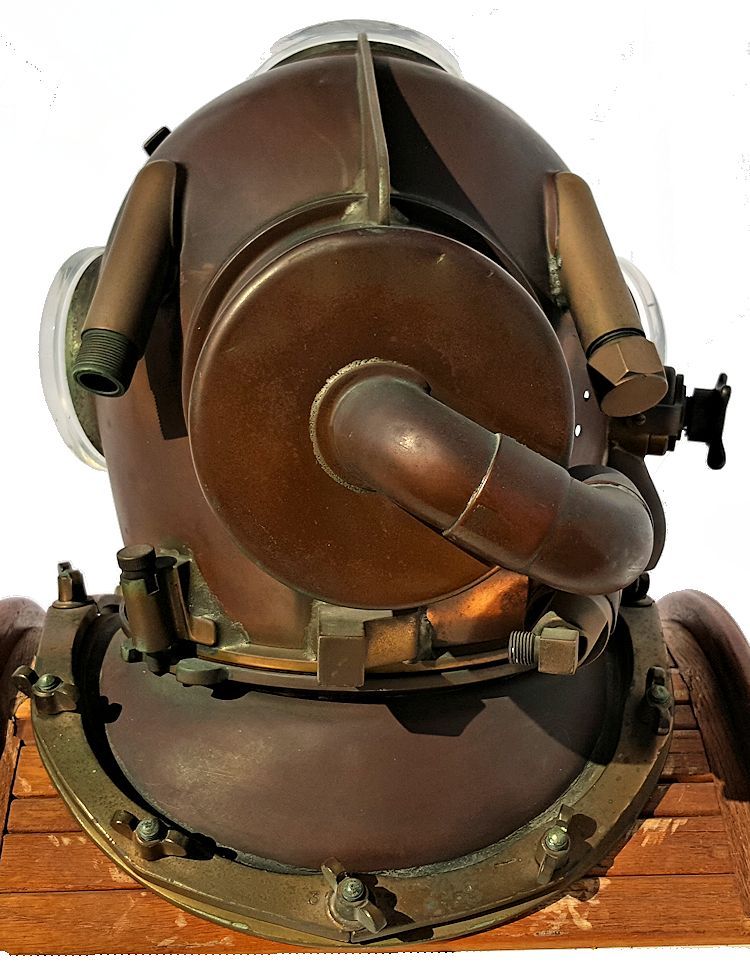 The back of
The back of
the Yoko Heliox helmet shows the cap on one elbow
HELMET MARKINGS: The brail tops are matching numbers 1 2 3 4 to line up when attaching to helmet. On the bottom of each brail is the
number 7. On the front two brails it has Yokohama diving on one and Apparatus Co Ltd. on the other.
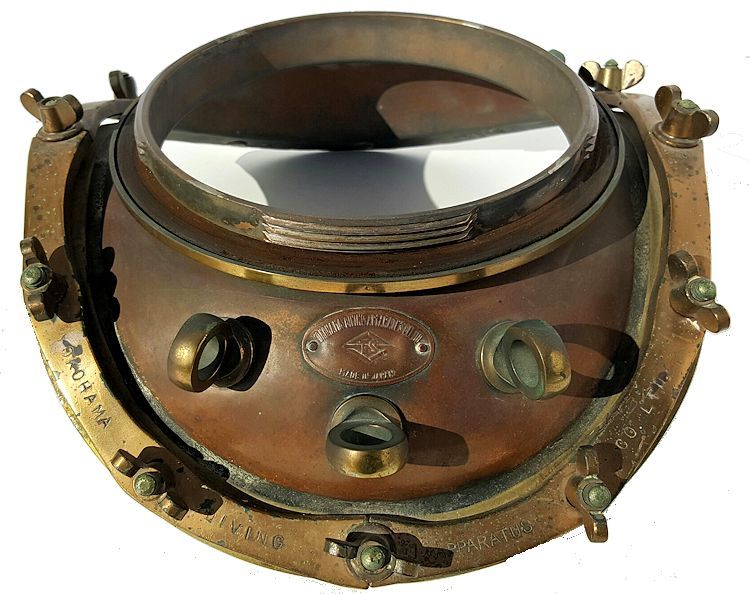
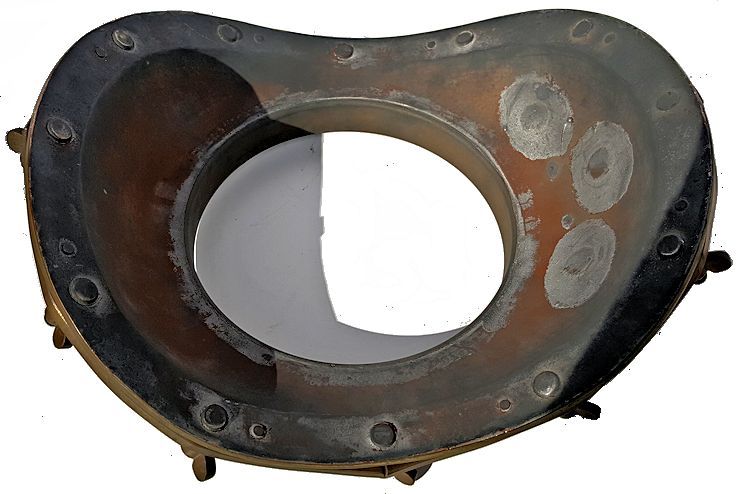 Top: Front of breast plate. Bottom: Inside of the breast plate
Top: Front of breast plate. Bottom: Inside of the breast plate
Like
all used diving gear, this is being sold for DISPLAY ONLY. It should not be dived without having passed inspection by a certified
dive shop.
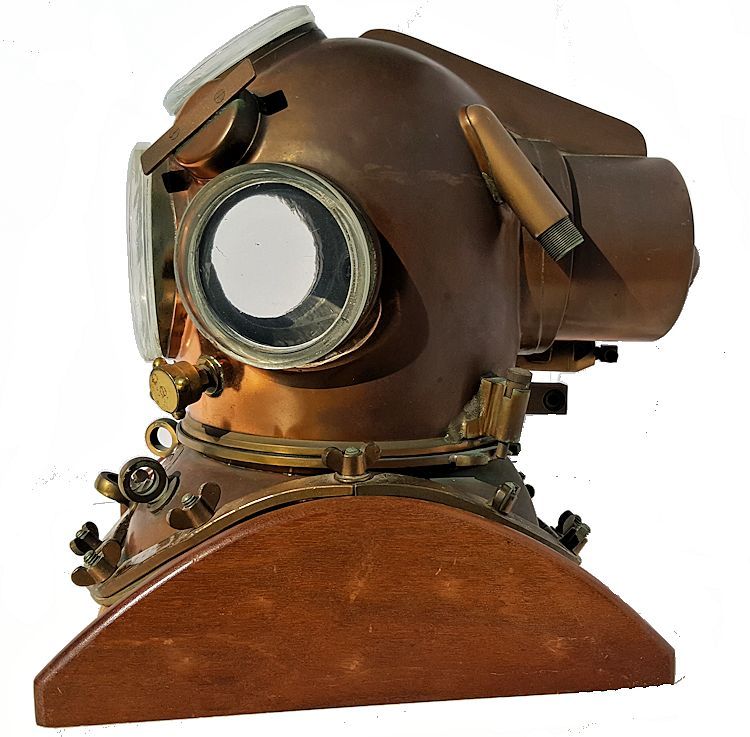
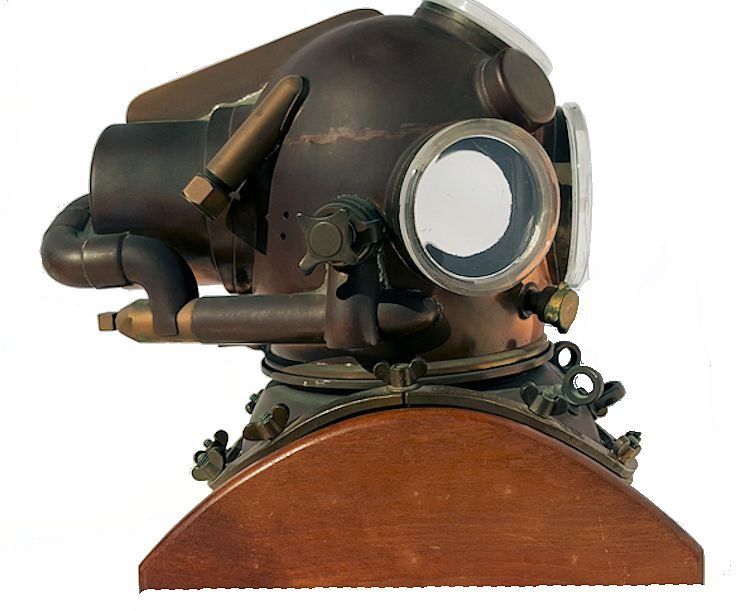 Both sides of the Yokohama Helium Hat
Both sides of the Yokohama Helium Hat
HISTORY OF THE YOKOHAMA HELIUM DIVING
HELMET
This Bob Kirby and Bev Morgan type Heliox helmet was manufactured by the Yokohama Diving Apparatus Co., Ltd. of Japan from 1966
to 1990. It was the first commercial type helium/oxygen dive helmet in the world and the first with a venturi recirculator
system. Incoming air is more effectively silenced winch improved communications while preventing hearing loss to the diver.
It’s design includes a permanently mounted canister that holds a standard Sodasorb(tm) Co2 absorbent chemical cartridge.
This replaced the shell natron that was used in earlier mixed gas designs that proved to be unsafe. It’s 4 one
inch thick threaded plexiglass lights are sealed against O rings improving visibility while eliminating the need
for grills used over the former glass ports.The design was an advancement in deep sea diving technology that
made reaching greater depths possible with less risk to the diver. Used by the US Navy and commercially, divers have reached
depths of 1,600 feet with these hats. Yokohama is no longer in business. Kirby Morgan is now called Diving Industries International.
